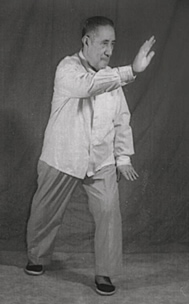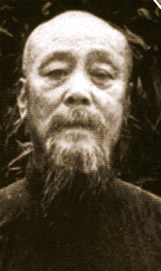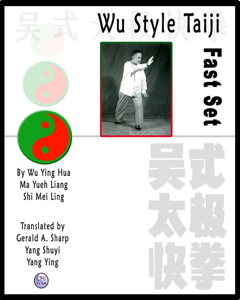|
1. Calmness The mind should be highly concentrated. No distractions should affect the thoughts. The mental process ought to be reduced. It’s not easy to make the central nervous system to focus. So how can we make the mind highly concentrated? The simplest way is to focus all the attention in how to do the correct form. On the other hand, it is also very useful to simply seek calmness during movement. In this way, it becomes more effortless to realize results.

Two Person Wu style sword, Wu Ying Hua and Ma Yueh Liang
|
2. Lightness (Softness) Lightness in Taijiquan cannot be simply measured in and of itself by the weight or the force. Lightness is contrasted with heaviness, according to the Taiji Classics, when it says, “When the left side is heavy, the right side is empty, and when the right side is heavy, the left side is empty.” When employing lightness, avoid the use of sudden force. Additionally, steer clear of being double weighted.
Lightness can also be explained as softness. The softest thing can be readily converted into the hardest. This means softness has potential force, but does not externalize it. On the other hand, this means that while something may appear loose, it may not be loose, and while something looks open, it may not actually be open. This is Taiji force. This is the highest level of practice in Taijiquan. These ideas are more understood over time and with continual practice.
|
|
3 a. Flexibility NOTE: This concept is called Flexibility in the Fast Set (Wu\\'s Original form) OR Slowness in the Slow Set (or, Long Form):
One of the most important ideas in Taijiquan is flexibility. Flexibility refers more to the spirit. The spirit is the control button of the body. When the practitioner is filled with the spirit, then the actions will be truly flexible. There are four things that will develop flexibility.
- First, combine stillness and motion.
- Second, combine softness and hardness.
- Third, combine quickness and slowness.
- Fourth, combine starting and finishing.
Stillness refers to pausing. Motion means change. During the practice of the Fast Set, maintaining the central equilibrium refers to stillness, jumping represents motion. Hardness means strong explosive force. Softness applies to fluidity of movement, and more specifically fluidity after the application of explosive force. When transitioning from one movement to another be immediate, and during the fast moments don’t hesitate to change. Extend slowness to create immediacy and change. The form ought to be practiced fully and large during the entire set. In the beginning stages, the movements ought to gradually open widely and progress forward, whereas, in the closing form, steadily reduce and be calm. This is how to combine the beginning and the end. Do not practice lackadaisically during any component. In other words, the Wu Style Taijiquan Fast Set is flexible by being continuous without stopping.
|
3 b. Flexibility (Slowness) continued Ma said that the concept of flexibility in the Wu Style Fast Set could best be realized by thinking of the body as a centrifuge. By this, Ma meant that the practitioner ought to be like a top, and have the ability to both gather momentum and spin like a top. This idea of centrifuge is achieved when all the other mental preparations, as well as the physical considerations, are followed with ease and the tailbone is sunk and kept at the center of all movements.

Ma Yueh Liang - Turn Body, Brush Knee
|
|
3 c . Flexibility (Slowness) Continued 
Slowness: Slowness refers not only to the length of time the Slow Set is practiced, which is usually 25-40 minutes, but practicing in a slow, efficient manner in order to promote the flow of chi and utilize patience in your practice. At times a fast response is required, even in Taiji Push Hands, let alone in unpredictable situations involving self-defense. However, acting too fast and hastily can be costly. Slowness allows the blood and chi to flow completely throughout the organism. Sudden or gross movements are not a good use of practice time.
Practice slowly and evenly from beginning to end, and follow the mind’s desire to be tempered by moving sequentially with the hands, eyes, body, and feet. Avoid moving the body without a strong sense of direction and specificity. To avoid sudden or disjointed movements, be patient. Let the chi and the movements come to you more. Wait on them to develop and move as if your organism and movements are joined together like a string of zigzagged pearls, moving to and fro without pause or stopping. Yet, stand erect (but not up), and use restraint. Move as if not moving, and combine stillness with motion and motion with stillness. Relax to move, and move to relax. The main point in Slowness is Patience.

|
4. Exactness Exactness refers to focusing your attention on the details. When practicing Taijiquan, spend quality time and practice seriously. Regardless of which form, you need to be accurate. Empty and Full needs to be identified clearly, and oversights ought to be avoided. The body ought to be consistently in the middle of all movements, and be calm and comfortable at all times. Explosive force should have the sensation of being both deep and calm also. Don?t be distracted with thoughts other than practice, and stay the course of practicing regularly.
Another meaning of exactness means to explore and analyze. After practice, review the process. Any inaccuracies in the form need to be corrected immediately. Practice in this way and you will have immediate, ongoing improvement.

Ma Yueh Liang - "White Stork Flaps its Wings" posture
|
|
5. Perseverance Perseverance has two meanings as follows: Establishing a daily routine and increasing repetitions. First of all, Taijiquan needs to be practiced consistently. No matter what occurs, you cannot stop. The amount of time to dedicate to practice is determined according to each individual’s physical condition and schedule, and in this way it can be concluded how many repetitions are beneficial. Both the time set aside, and the amount of time that is spent, are increased over time with patience. A prominent quote attributed to Teacher Ma goes like this: "There's no mystique to T'ai Chi Ch'uan. What's difficult is the perseverance. It took me ten years to discover my chi, but 30 years to learn how to use it."

Ma Yueh Liang - "Strum the Lute" posture
|
Conclusion In closing, calmness, lightness, flexibility, exactness, and perseverance can be compared to the relationship shared by the Mutual Order of the Five Elemental Phases of Metal, Water, Wood, Fire, Earth..., which work together and progressively "feed" or support the next phase in the order.
Note: Some of the information on this page is from the book, "Wu Style Taijiquan Fast Set," by Wu Ying Hua, Ma Yueh Liang, and Shi Mei Ling, and translated into English by Gerald A. Sharp, Yang Shuyi, and Yang Ying.

Return to chiflow Main Page
|











